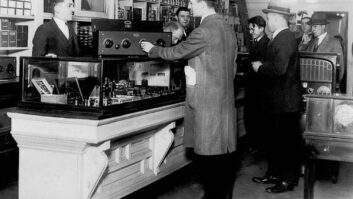New Standards for Towers Near Historic Sites
Mar 1, 2002 12:00 PM, By Harry Martin
According to a new fact sheet to be issued by the FCC, broadcasters who propose to locate their antennas on new towers near historic sites will face greater scrutiny to determine the environmental impact of their towers.
The proliferation of wireless towers has drawn the ire of the National Conference of State Historic Preservation Officers (NCSHPO), which sees the recent rapid increase in towers as a threat to historic sites. With their consciousness raised, NCSHPO and the Advisory Council on Historic Preservation (ACHP) signed an agreement with the FCC on March 16, 2001 to protect historic sites from encroaching towers. The new fact sheet, which is available at www.fcc.gov/mmb/mmb_siting.html, embodies this agreement.
The agreement encourages collocation on existing towers, buildings and other structures, striving to protect historic properties while reducing the need for new towers. However, the agreement � which is peppered with references to the wireless communications facilities that inspired it � is ambiguous as to its applicability to broadcasters. The fact sheet, released jointly by the FCC’s Wireless Telecommunications Bureau and Media Bureau, clarifies that broadcasters are indeed covered. In fact, broadcasters may face serious sanctions, such as fines, if they locate on a structure that does not adhere to the agreement.
The terms of the agreement are straightforward. Commission licensees and applicants must comply with National Historic Preservation Act (NHPA) procedures for facilities that may affect sites that are listed or eligible for listing in the National Register of Historic Places. If a broadcaster’s antenna is located on a tower, building or other structure constructed on or before March 16, 2001, the broadcaster likely falls under the agreement’s grandfathering clause and will not need new review under the NHPA, except under enumerated special circumstances.
But if a broadcaster is located on a tower, building or structure built after March 16, 2001, it must ensure that the tower has passed muster under the NHPA and has documentation to prove it. Collocation on a new tower will still require review if: (a) the NHPA analysis is not yet complete; (b) the FCC has determined that the collocation has a continuing adverse effect on an historic property; (c) a complaint against the collocation’s impact on an historic property is before the FCC; or (d) the collocation will result in a substantial increase in the size of the tower.
Broadcasters who locate on new towers that were built after March 16, 2001 but which have not undergone historic review may face sanctions. To avoid this fate, broadcasters should check with the relevant State Historic Preservation Officer before putting their antennas on a �new� tower. Also, broadcasters leasing space on �new� (i.e., post-March 16, 2001) towers might also consider insisting on a clear provision in their lease agreements requiring the tower owner to demonstrate and maintain its compliance with NHPA.
Independent reviews by the FCC, ACHP and NCSHPO of the impact of collocations on historic sites have been infamously cumbersome, often resulting in long construction delays. The NCSHPO/ACHP/FCC agreement is intended to streamline that process. The fact sheet, in turn, provides guidance to broadcasters on how to satisfy NHPD requirements and speed review of requests to collocate on new towers. Additionally, the ACHP has organized a telecom working group to streamline historic preservation siting requirements and create a model that individual states may use to speed their own reviews of the impact of communications antenna and related infrastructure on historic sites.
EEO update
In January, the Supreme Court declined to consider an appeal of a decision by the federal appeals court in Washington, holding that the FCC’s former equal employment opportunity rules were unlawful. The Supreme Court’s decision is the end of the line for the Commission’s old EEO rules, which had been adopted in 2000.
Dateline:No biennial ownership reports are due in 2002. However, new permittees, new licensees as well as parties acquiring stations are required to file ownership reports within 30 days after approval of a construction permit, the filing of an initial license application or the consummation of a transfer or assignment.
Martin is an attorney with Fletcher, Heald & Hildreth, PLC., Arlington, VA. E-mail[email protected].












